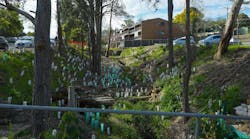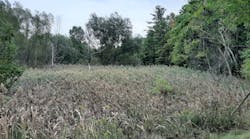It's All About Water
Rainwater. Storm water. Wastewater. Unmanaged, they can endanger waterways, groundwater and add to water shortages. There is no simple solution, but what is clear is that the trajectory of diminishing clean water supplies can only be reversed if we address it in every way possible. At a time when water shortages are becoming acute – even in historically water-rich regions – the collection, treatment and management of all kinds of water has never been more interconnected. That includes looking more seriously at rainwater and its connection to groundwater.
The United Nations chose groundwater as its 2022 World Water Day theme to increase understanding about the importance of it. In her forward to the report, Audrey Azoulay, the director-general of UNESCO, writes that “groundwater is a critical natural resource, invisible but indispensable for life on our planet. Indeed, nearly 50% of the world’s urban population depends on underground water sources. Yet more and more aquifers are being polluted, overexploited and dried up by humans, sometimes with irreversible consequences. Moreover, many decision-makers in the water field lack a clear notion of groundwater, despite its essential role in the water cycle.”
The direct connection between groundwater and rainwater is clearly drawn in the 2022 UN Water Report. It names “managed aquifer recharge, rainwater harvesting and enhanced infiltration” as a way to restore groundwater quality and quantity, as well as aquifer storage.
In countries like the U.S., regional precipitation – including rain, sleet, snow and hail – varies widely. The annual average in the past 10 years ranged from approximately 27 to 35 inches. In the 2021 the average was 30.48 inches. According to the National Oceanic and Atmospheric Administration’s 2021 National Climate Report, the lowest precipitation was in Nevada (with 9+ inches), Arizona (with 11+ inches) and Wyoming (with 13+ inches). On the other end of the spectrum are states like Louisiana (with 59+ inches), Mississippi (with 56+ inches) and Alabama (with 56 inches).
The dry regions of the country have the most endangered aquifers. After more than two decades of drought conditions, water levels at the Hoover Dam reservoir are at their lowest levels since it was filled nearly 90 years ago. Water supplies for power generation and other essential uses in Southwestern states, such as Arizona, Nevada, and Mexico are at risk.
Even in the Plains states, which have not historically had chronic water shortages, the Ogallala-High Plains Aquifer is at risk. This aquifer, one of the largest sources of groundwater in the world, extends across eight states and supports the largest U.S. crop production in this region, extending from South Dakota through Texas. Abundant water use from the aquifer for agriculture endangers the drinking and emergency water needed by local communities. The primary factors behind depleted aquifers are clear, depending, in part, on geological and climatic factors. Universally, significant factors are:
- Lower rates of rainfall and snowfall;
- Higher rates of tapping aquifers for human use, including drinking water and irrigation; and
- Increasing areas of impervious paved surfaces due to development, especially in urban areas.
There are no quick fixes to replenishing aquifers. They can take hundreds or thousands of years to be replenished to a level sufficient to meet human needs. What is possible is to act in ways that halt (or slow) further depletion and that replenish aquifers with uncontaminated water. Many of those ways include managing and treating rainwater.
Regional and state jurisdictions increasingly regulate the collection, treatment and reuse of rainwater. Since there is no federal regulation in the U.S. governing rainwater collection, regulations vary, and factor in such elements as the local definition of “water rights” and availability of water supplies. The regulatory picture can be categorized as:
- No restrictions, no incentives;
- No restrictions, incentives offered;
- Some restrictions, no incentives; and
- Some restrictions, incentives offered.
The majority of states have no restrictions regarding rainwater collection. Many states actually encourage rainwater harvesting by offering incentives (sometimes including tax rebates). States with no restrictions, but that offer incentives, are sprinkled across the country – from Western states such as Arizona, Hawaii, New Mexico and Wyoming, to Midwestern states such as Minnesota, and to East Coast states such as Florida, Maryland, New Jersey and Pennsylvania.
States that have some restrictions for rainwater harvesting, but also offer incentives include California, North Carolina, Oregon, Rhode Island and Texas. A handful of states go further, requiring a permit for rainwater catchment. Those states tend to be in the West, such as Colorado, Oregon and Washington. Examples of states with some restrictions but no incentives are Arkansas, Colorado, Georgia, Illinois, Nevada, Ohio, Utah, Virginia, Washington and Wisconsin.
One clear indicator that this water solution is gaining recognition is the number of jurisdictions that have published guidance manuals about rainwater treatment and management methods that meet local water-quality objectives. Cities such as Portland, Los Angeles, San Francisco and Tucson, along with states like Georgia, North Carolina, Texas and Virginia have all published such documents.
Manuals such as the Texas Manual on Rainwater Harvesting and the San Francisco Rainwater Harvesting Manual detail the factors to be considered when creating a system. Many also present calculators for determining the exact system needed for site conditions. To encourage not using green space for the cisterns, some manuals highlight fiberglass underground storage tanks as a solution. The San Francisco manual specifies that the tank “should be opaque, durable, able to withstand the forces of standing water, watertight, clean, have a smooth inside, be sealed with a non-toxic joint sealant, and easy to operate.”
Besides the tank, other components can include a water inlet, water outlet, overflow pipe, access hatch and draining method. Treatment can be obtained with products removing debris and pollutants, and through physical and chemical processes, including filtration. States, such as California, require systems to be equipped with debris removal before water enters the tank. Additional treatment components are installed to remove other pollutants if the water is to
be reused.
Some jurisdictions provide incentives for property owners and developers by offering storm water credits that can achieved either by a single storm water best management practice (BMP) or through several BMPs. It can be as simple as project components that:
- Encourage the preservation of natural areas;
- Reduce storm water volume;
- Comply with permit requirements; and
- Meet water-quality goals.
Rainwater harvesting systems are usually found either at the beginning or the end of a storm water treatment train. For instance, rainwater systems that collect water from rooftops are usually placed at the beginning of a storm water system, whereas water retention or detention systems are generally placed at the end of a treatment train, such as storm water chambers. Those chambers can be combined with further filtration components or can be lined for further pollutant removal.
Rainwater can be either treated for reuse or released. When collected or treated, it is typically used for either outdoor use such as irrigation or indoor non-potable uses such as toilet flushing or clothes washing. When treated and released, it eventually replenishes waterways, groundwater and aquifers.
Either way, each private or public property with a rainwater collection and treatment system contributes in some measure to cleaner groundwater and replenished aquifers.
- Environmental Protection Agency, Rainwater Harvesting: Conservation, Credit, Codes and Cost
- The United Nations World Water Development Report 2022: Groundwater: Making the invisible visible
- City of San Francisco, San Francisco Rainwater Harvesting Manual
- Texas Water Development Board, The Texas Manual on Rainwater Harvesting
About the author:
Ann K. Ryan has written for international publications for more than 30 years. She is also a communications consultant for Shawcor. Bruce Coe is the regional sales manager, Western North America, for Shawcor. Ryan can be reached at [email protected]. Coe can be reached at [email protected].


